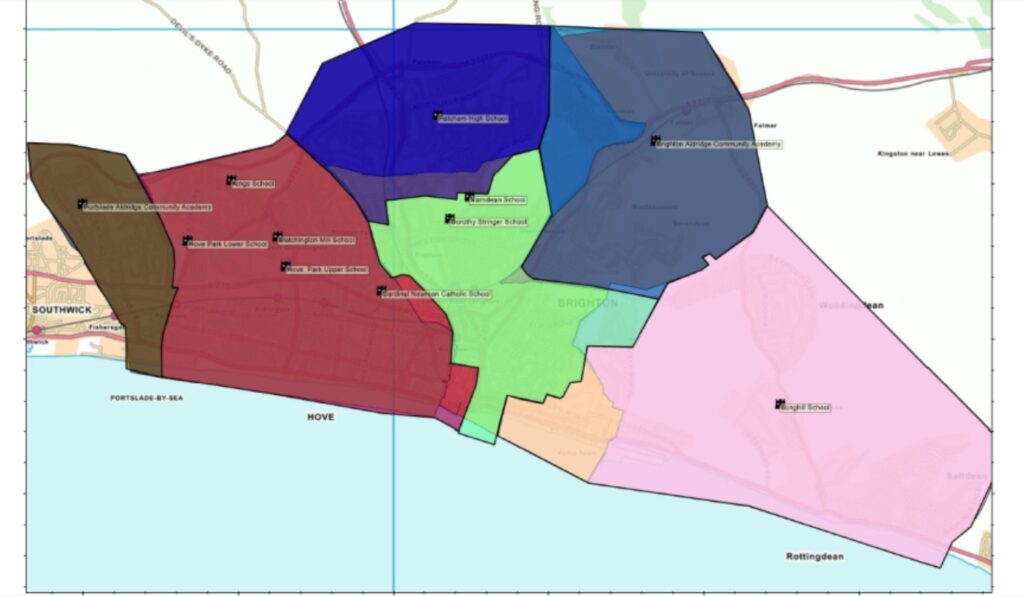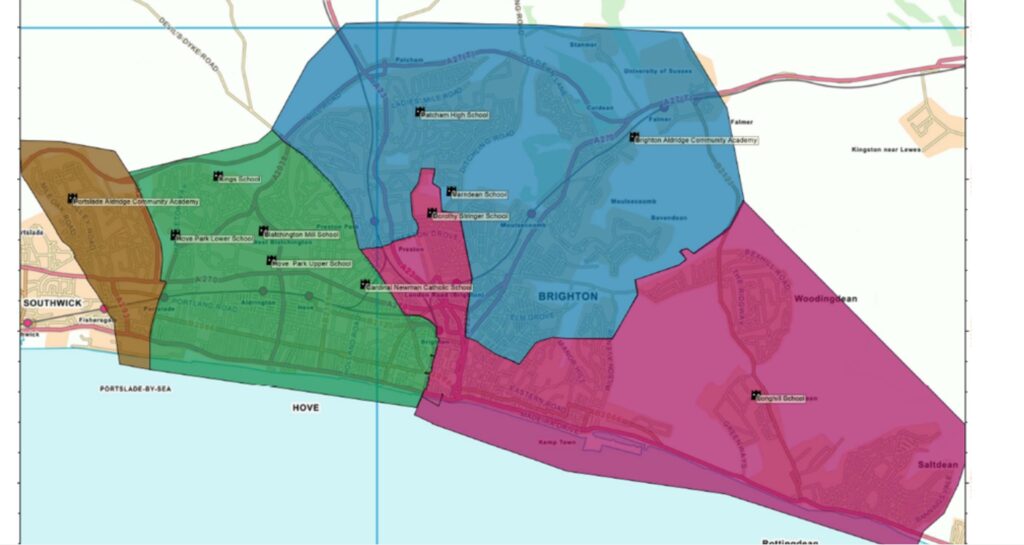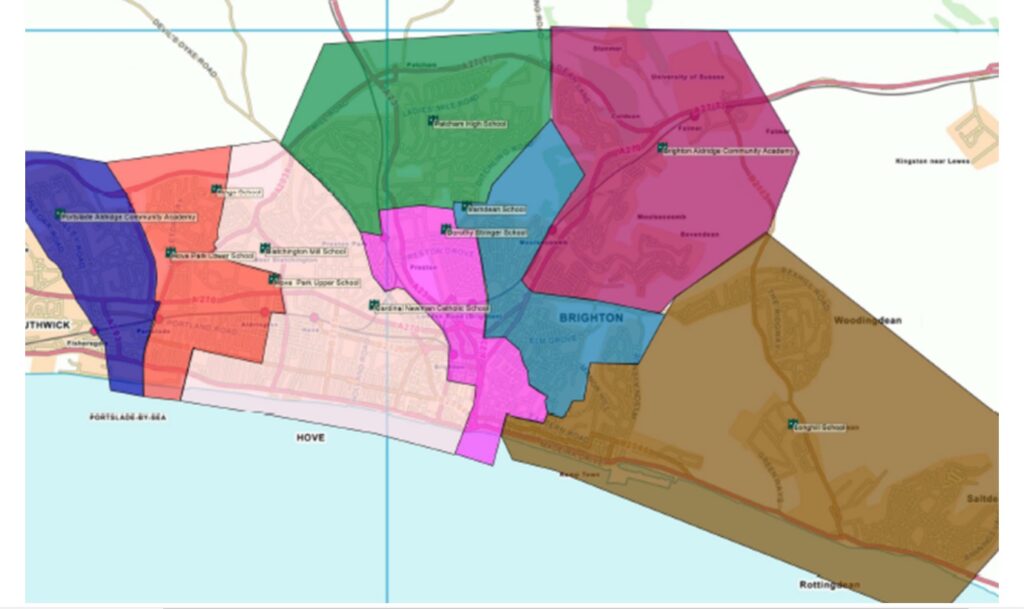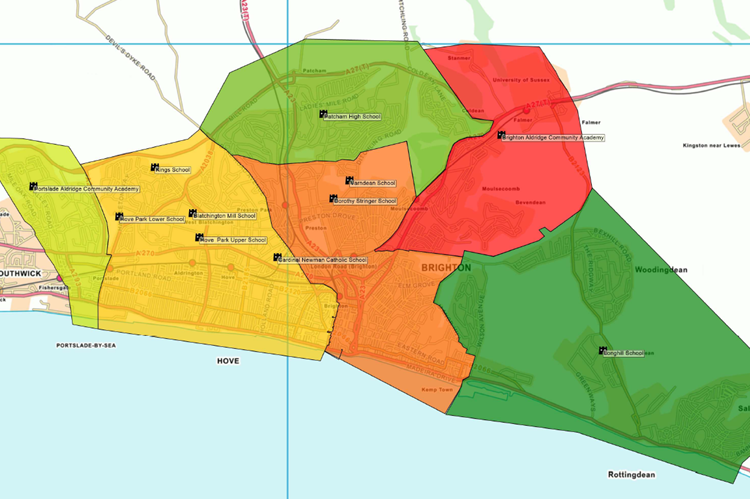Parents living near two popular secondary schools fear that their children could have to travel miles on leaving primary school if proposed catchment area changes are approved.
Brighton and Hove City Council is currently holding an “engagement exercise”, asking parents for their views on proposed changes to admissions and catchment areas for secondary schools.
The proposals outline three options aimed in part at addressing falling pupils numbers from September next year.
People living in Friar Road, Friar Crescent, Friar Walk and Friar Close, Brighton, are concerned that all the proposed changes remove Dorothy Stringer from all three of their proposed secondary school catchments.
Many of them live less than 200 yards from Stringer and two of the proposed catchments – options A and C – also remove them from the catchment for neighbouring Varndean.
Option B proposes a catchment that would include Varndean, Patcham High and the Brighton Aldridge Community Academy (BACA) which is almost three miles away.
Friar Crescent resident Paul Herbertson said that the proposals could result in his five-year-old son going to secondary school far away from his friends who live in neighbouring streets.
Mr Herbertson said: “The ‘consultation’ process and period does not instil faith that the council wants to listen to the communities this so greatly affects.
“Three weeks is no time at all for a consultation of this magnitude. Information regarding the proposals has been poorly presented with many reporting accessibility issues.
“In-person meetings were initially set at only one and at a key time when parents would need to be getting children to bed. It has been poorly advertised, with many parents still having no idea that it is happening.”

After meeting neighbours, Mr Herbertson wrote to the leader and deputy leader of the council and members of the council’s People Overview and Scrutiny Committee which is due to discuss the proposals today (Wednesday 9 October).
He wrote: “I appreciate the need for ensuring all children in the Brighton and Hove area should have access to a good school. Disregarding the geographic reality seems extraordinarily short-sighted.
“It will divide communities, something so important to and characteristic of Brighton and Hove, increase traffic and reduce the number of children walking or cycling to school and there is little/no evidence that this approach will achieve the aims.
“Indeed, the council refers to the Sutton Trust report which recommends the admissions policies are changed not boundaries.”

After the council announced public meetings and its engagement process, neighbours created a paper petition and have applied for an electronic version on the council’s website.
Falling pupil numbers have already led to councillors voting to close two primary schools – and from September next year fewer children are expected to go to local secondary schools.
Funding is based mainly on pupil numbers and a key aim of the review is to cut 345 year 7 classroom places – from 2,560 to 2,215 – by September 2030.
The initial proposals would involve cutting 90 places a year from the published admission number (PAN) at both Blatchington Mill and Longhill, 60 places at both Dorothy Stringer and Varndean and 45 places at Patcham High.
No change is proposed at four schools which are either academies, free schools or faith schools because they set their own admission numbers.

Three online meetings are scheduled for parents and carers at 6pm on Thursday (10 October), 6.30pm on Wednesday 16 October and 11.30am on Monday 21 October.
Once the initial engagement, is complete a report is due to go to the cabinet before a formal six-week consultation on the Your Voice section of the council’s website.
When the current engagement started, Councillor Jacob Taylor, the deputy leader of the council, said: “We want to build an education system in the city that is fair and inclusive where all pupils can access a great education.
“To do this, we need to address educational inequality in the city, as well as the issue of falling pupil numbers in our secondary schools.
“We’re launching this engagement to identify solutions and ensure the opportunities and outcomes of our children and young people are not dictated by their background.
“We’ve developed three different models that could tackle these issues and ensure all secondary schools in the city are able to thrive. We are keen to hear from parents, carers and the wider community about these options.
“The rules on school admissions mean that we cannot propose a change across all schools in the city but we hope to work with academy and church schools to do what is right for Brighton and Hove’s children and young people.”
The People Overview and Scrutiny Committee is due to meet at Hove Town Hall at 4pm today (Wednesday 9 October) to discuss the proposals. The meeting is scheduled to be webcast on the council’s website.









It appears that it is the children who are being asked to address “education equality,” rather than the council.
There is never going to be a perfect solution to this because edge cases are always going to be aggrieved. It is the same with any kind of means testing that doesn’t taper.
Not that I have a solution here…sounds like if all the school provide an equally good service, it wouldn’t matter where the boundary lines were?
A large part of the problem though is the framing of the consultation by the council. The questions are leading and just odd, so it looks like they already have a clear idea of the outcome they are trying to achieve.
Why were discussions not happening with the school community to discuss what the options should be. If the council had any respect or intention of listening to residents in the city, surely they would have properly engaged with us at that stage – rather than the council deciding the options – and basically saying you can have this one, this one, or this one.
Obv nobody is against addressing education inequality, people are annoyed because of the framing of this whole “conversation” with residents, at a point where options have been decided and there’s little people can do to input.
Have heard zero from Councillor Jacob Taylor that he’s doing anything to press the Labour Government to tackle problems in the way schools are funding either, or to right the underfunding that has happened. He should also be doing that if he really means what he says about tackling inequality – but I can’t see he is.
“If the council had any respect or intention of listening to residents in the city, surely they would have properly engaged with us at that stage ”
The problem with that is that only certain overall schemes are valid given the constraints. However, every parent in the city will say “I demand that my child attends an excellent school the absolute minimum distance away” and that’s not helpful feedback. How many parents will have any information about where populations of children are in the city, the relative strengths of the schools, the necessary PAN for each school, etc? None, or near enough none. Frankly, this should never have gone out to public consultation in the first place.
Look at the map: If a child lives on Friar Road they’re going to be going a little less than a mile to Patcham High. Hardly an arduous journey, about a twenty minute walk for most, and that in turn saves journey times for children living south of there AND regulates the admission numbers to keep the schools open in the first place.
I’m not talking about which option is right or wrong, if it’s a genuine consultation that should still be up in the air and not known. The council deciding the options to include in the ‘engagement exercise’ in the first place without even discussing with school communities at the outset, and then asking people to comment on them with such limited information, and with such leading question, isn’t great imo.
The Labour council screwed up multiple consultations last year with primary schools and the council’s decisions on 3 or 4 of them got overturned by the independent adjudicator when school’s appealed – they don’t have good form on running a consultation on prickly and divisive issues like school arrangements and places. That was proven last year, and worryingly seems to be happening again from the initial feedback coming up.
Labour just lost the next council election with a series of poor decisions. I guess this cabinet model is to be blamed. I wonder how many of their councillors will jump this sinking ship!!!
Party candidates are often chosen based on loyalty and connections rather than competence or experience. Aspiring politicians must navigate an opaque and highly competitive selection process, which often favours party insiders over genuinely capable individuals.
Sounds like a good system
Of course it favours insiders, they aren’t going to elect a Green candidate now, are they?
I’m so pleased to see that efforts are being made at last to deal with the inequalities for children across our city. And this isn’t the consultation happening now, it’s just the engagement part, prior to a consultation. I do hope we see change in catchment areas soon. The Greens would never have dared to make the changes needed , as all their voters live in the middle class area, but Labour are the ones to make this happen, as they have councillors and voters across almost every ward of the city.
It’s clear to me that none of these comments are from people who have children who will be affected by the changes. I would love for all children to have equal access to good quality education, It doesn’t make any sense to me why that means kids travelling miles to school when they have one 2 minutes walk away though.. you should have access to your nearest school and that should be the priority. This means kids can walk to school and feel safe doing so, and parents and families can have access to a local supportive community of people who live nearby. In order to improve struggling schools more funding is needed and incentives to get good teachers into struggling schools.
I thought this was a city keen on preserving the environment, whereas this will mean lots more people driving to school, when they could easily walk. It doesn’t make any sense.
I agree. There seems to be a perception of “better school” and gaining access to that one. I think the better challenge, rather than boundaries would be, how can those schools that are underperforming do better?
If it’s a question of higher numbers of low socioeconomic demographics, how are families in that area being supported to create learning environments outside of schools, for example?